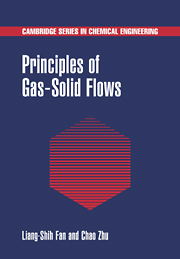Book contents
- Frontmatter
- Contents
- Preface
- Part I Basic Relationships
- 1 Size and Properties of Particles
- 2 Collision Mechanics of Solids
- 3 Momentum Transfer and Charge Transfer
- 4 Basic Heat and Mass Transfer
- 5 Basic Equations
- 6 Intrinsic Phenomena in a Gas–Solid Flow
- Part II System Characteristics
- Appendix: Summary of Scalar, Vector, and Tensor Notation
- Index
2 - Collision Mechanics of Solids
from Part I - Basic Relationships
Published online by Cambridge University Press: 27 October 2009
- Frontmatter
- Contents
- Preface
- Part I Basic Relationships
- 1 Size and Properties of Particles
- 2 Collision Mechanics of Solids
- 3 Momentum Transfer and Charge Transfer
- 4 Basic Heat and Mass Transfer
- 5 Basic Equations
- 6 Intrinsic Phenomena in a Gas–Solid Flow
- Part II System Characteristics
- Appendix: Summary of Scalar, Vector, and Tensor Notation
- Index
Summary
Introduction
In particulate multiphase flows, collision occurs between the particles or between the particle and the wall. In gas–solid flows, the collision frequency mainly depends on the particle concentration and particle size, although it is also influenced by the flow pattern and system configurations. Kinetic energy loss of the particles due to collisions may occur and can be in the form of frictional heat generation, wall surface erosion, particle breakage (attrition), particle deformation, particle agglomeration, or solid electrification. The total momentum of all colliding bodies obeys the law of conservation of momentum, namely, the total momentum before collision equals the total momentum after collision. However, as a result of the collision, the momentum of each individual particle may change.
A collision without permanent deformation or heat generation is called an elastic collision. Otherwise, the collision is inelastic and energy loss occurs mainly in the form of permanent deformation such as particle breakage and frictional heat loss. Generally, a force is exerted on the particle by its colliding counterpart during the collision. This force is expressed as an impulse, which is defined as the product of the force and the duration of the collision. From Newton's law, the impulse is equal to the momentum change of the particle during the collision. Thus, for the same change in momentum, a shorter duration requires a larger impact force. It is this impact force that causes the momentum transfer from one particle to other particles, particle deformation or breakage, and frictional heat loss.
- Type
- Chapter
- Information
- Principles of Gas-Solid Flows , pp. 46 - 86Publisher: Cambridge University PressPrint publication year: 1998
- 1
- Cited by



